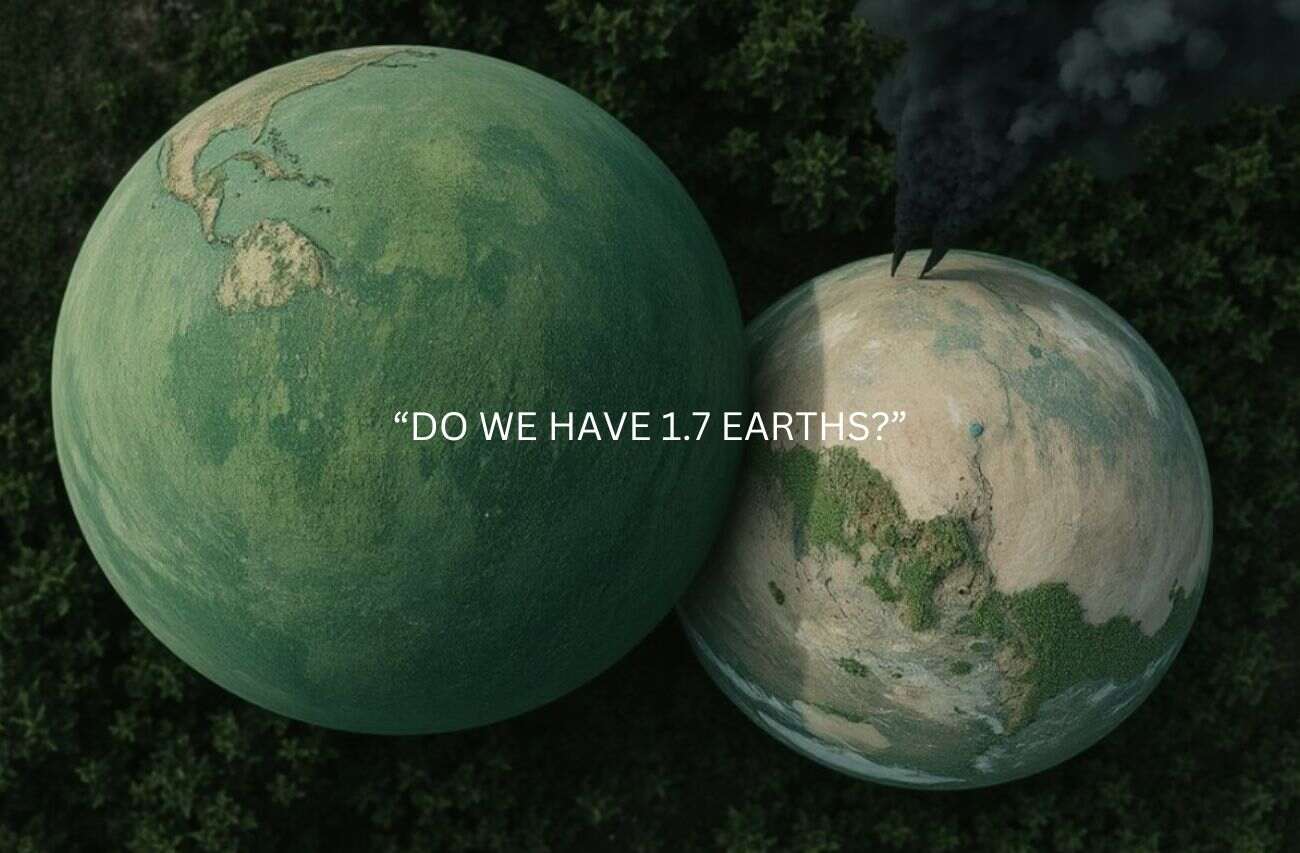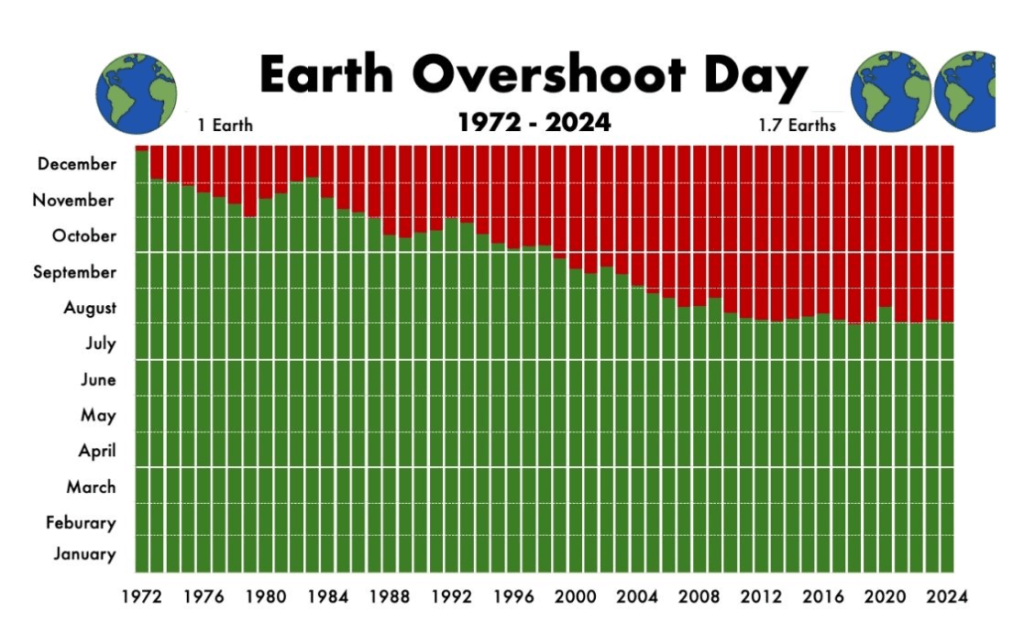
Earth Overshoot Day: Sustainable sourcing in wholesale
n 2024, humanity faced a harsh reality when Earth Overshoot Day arrived as early as August 1st, signaling that our demand for natural resources had outpaced what the planet can replenish in a year. It is a clear signal that we need to rethink how we use and manage the planet’s resources before we push the limits too far.
‘Earth Overshoot Day’ serves as a stark reminder that we are depleting our natural resources at an unsustainable rate. This overconsumption leads to deforestation, loss of biodiversity, and increased carbon emissions, pushing our planet beyond its ecological limits.
This issue is particularly pressing for the wholesale industry, which plays a pivotal role in the global supply chain. As intermediaries between producers and consumers, wholesalers have a unique opportunity (and responsibility) to champion sustainable sourcing practices. By prioritizing sustainability, the wholesale sector can help mitigate environmental impact, promote resource efficiency, and drive the market towards more eco-friendly solutions.
At Qalara, we are committed to taking significant steps towards sustainable sourcing, setting an example for the industry.
Stay with us as we delve deeper into how the wholesale industry can lead the charge toward a more sustainable future. Discover actionable insights and practical strategies that can make a real difference.
Table of contents:
A call to action for the wholesale industry
Why action is needed before it’s too late
Steps for wholesalers to move towards sustainability
- Eco-friendly suppliers: finding sustainable partners in sourcing
- Waste reduction: strategies for minimizing waste
- Circular economy: implementing recycling and reuse practices
- Transparency and traceability: implementing robust tracking mechanisms
- Renewable energy: adopting sustainable energy solutions
- Certifications and standards: to validate sustainable practices
- Sustainability audits: how to evaluate your practices
- Aligning with global goals: connecting sustainable sourcing efforts to SDGS
What is Earth Overshoot Day?

Earth Overshoot Day explained
Earth Overshoot Day marks the point each year when our consumption of ecological resources surpasses what the planet can restore within that same year. It’s calculated by dividing the Earth’s biocapacity (the natural resources the planet can produce) by humanity’s ecological footprint (our consumption of those resources), then multiplying the result by 365 days. This calculation is performed annually by the Global Footprint Network, an international research organization. By acknowledging this day, we are prompted to reflect on our impact, rethink our resource use, and commit to more sustainable practices to protect the planet for future generations.
Global impact of resource overconsumption
The significance of Earth Overshoot Day lies in its stark illustration of our unsustainable consumption patterns. By this date, we have effectively used up all the resources that Earth can renew in a year, creating a deficit that we only sustain by depleting natural capital and accumulating waste, primarily in the form of carbon dioxide. This excessive use of resources results in environmental damage, such as deforestation, biodiversity loss, and a rise in greenhouse gas emissions.
These issues not only contribute to climate change but also exacerbate ecological crises, threatening the delicate balance of our ecosystems and jeopardizing the well-being of future generations. It serves as a powerful reminder of the urgent need to rethink our consumption habits and embrace more sustainable practices for the health of our planet.
Trends in earth overshoot day

Over the decades, Earth Overshoot Day has been arriving earlier, reflecting not only our accelerating depletion of the planet’s resources but also a lack of effective systems and efforts to address this issue.
Let us look at some shocking data: In 1970, the Earth Overshoot Day fell on December 29th; by 2000, it had advanced to October 4th, and in 2024, it arrived as early as August 1st. This alarming trend indicates that we are consuming resources at the rate of 1.75 Earths to sustain our lifestyle. If we don’t reverse course, the consequences for our planet, and for our future generations, could be devastating.
Also read: The causes & dangers of over-production
On a positive note, as Global Footprint Network states, “the rate Earth Overshoot Day has moved up on the calendar has slowed to less than one day a year on average in the past five years, compared to an average of three days a year since overshoot began in the early 1970s.” This slowdown indicates that there is potential for change and that collective efforts toward sustainability can make a difference.
Also read: Do customers care about sustainability?
The wholesale industry's role in resource consumption
Assessing the wholesale industry's footprint
The wholesale industry plays a pivotal role in the global economy, but its environmental footprint is substantial. According to a report by Staze, the carbon footprint of companies in the wholesale sector is primarily composed of direct (scope 1) emissions, which account for approximately 44% of their total carbon footprint. These emissions stem from activities such as fuel consumption in company vehicles and on-site equipment. Additionally, the industry is responsible for considerable waste generation and raw material consumption, further exacerbating its environmental footprint.
Beyond carbon emissions, the wholesale industry significantly impacts natural resources through its extensive use of raw materials. For instance, the demand for packaging materials, often derived from non-renewable resources, leads to increased deforestation and depletion of natural habitats. The sector’s reliance on fossil fuels for transportation and logistics also contributes to air pollution and greenhouse gas emissions.
In addition, waste generation is a major challenge in the wholesale industry. The disposal of unsold goods, excess packaging, and obsolete inventory results in substantial waste, much of which ends up in landfills. This not only poses environmental hazards but also represents a loss of valuable resources that could be recycled or repurposed.
The global sourcing industry’s carbon footprint further underscores the wholesale sector’s environmental impact. The World Economic Forum identified that eight major supply chains, including those for food, construction, fashion, and electronics, account for more than 50% of global greenhouse gas emissions. Additionally, the agri-food supply chain alone was responsible for 5.8 billion tonnes of greenhouse gas emissions from supply-chain processes in 2019. These figures highlight the critical role that supply chains play in the overall carbon footprint of industries worldwide.
In summary, the wholesale industry’s environmental footprint is multifaceted, encompassing carbon emissions, raw material consumption, and waste generation. Addressing these challenges requires a comprehensive approach that includes optimizing resource use, reducing emissions, and minimizing waste.
Also read: What makes Qalara a planet-friendly choice
Key contributors to resource depletion
Within the wholesale industry, certain sectors are particularly notable for their contribution to resource depletion. The textile sector, for instance, is a major consumer of water and energy, with the production of raw materials like cotton and synthetic fibers leading to significant environmental degradation. The food wholesale sector also has a substantial impact, driven by the extensive use of water, land, and energy in food production and distribution. Furthermore, the electronics sector is a key contributor, with the extraction of rare minerals and the generation of electronic waste posing serious environmental challenges.
Qalara's journey toward responsible sourcing
Qalara is continuously working to be a more responsible wholesaler by taking significant steps toward sustainable sourcing. With a growing focus on eco-friendly practices, fair trade principles, organic products, and handmade goods, Qalara is committed to making thoughtful decisions that positively impact the environment and the communities it partners with.
Eco-friendly efforts
Qalara is actively exploring eco-friendly options by sourcing products made from sustainable materials and encouraging the use of renewable resources. From promoting recycled materials to new innovations, the goal is to reduce the environmental footprint and offer greener choices to wholesale buyers.
Moving toward fair trade
Qalara is making fair trade a key part of its sourcing efforts, collaborating with suppliers who champion ethical practices. By supporting fair wages and safe working conditions, Qalara aims to uplift artisans and farmers, fostering a more equitable supply chain that benefits everyone involved.
Supporting handmade artistry
Qalara values handmade goods and the preservation of traditional craftsmanship. By supporting artisans and their communities, Qalara is helping to create economic opportunities while promoting products that often have a lower environmental impact compared to mass-produced alternatives.
Through these initiatives, Qalara is taking steps toward creating a more sustainable sourcing model, one that aligns with ethical values and environmental responsibility. The company recognizes that the journey to becoming a fully sustainable wholesaler requires continuous effort and improvement, and Qalara is committed to making meaningful progress.
Why sustainable sourcing is critical
What is sustainable sourcing in wholesale?
Sustainable sourcing in the wholesale industry involves procuring materials and products in a manner that is ethically and environmentally responsible. This means prioritizing materials with a low environmental impact, ensuring fair labor practices, and supporting suppliers who adhere to ethical standards. Sustainable sourcing aims to minimize negative environmental and societal effects while maintaining economic viability.
Ethically sourced materials are those obtained without exploiting workers or violating human rights. This involves guaranteeing fair wages, providing safe working conditions, and upholding workers’ rights. For example, the Fair Trade certification ensures that products are made under fair labor conditions, providing better livelihoods for workers and their communities.
Environmentally responsible sourcing focuses on reducing the ecological footprint of products. This involves selecting materials that are renewable, recyclable, or have a lower carbon footprint. For instance, sourcing organic cotton, which uses less water and fewer pesticides compared to conventional cotton, can significantly reduce environmental impact.
Economic and environmental advantages
Sustainable sourcing offers numerous long-term benefits, both economically and environmentally. By reducing resource strain, companies can ensure the availability of essential materials for future use. According to the Ellen MacArthur Foundation, adopting circular economy principles, which include sustainable sourcing, could generate $4.5 trillion in economic benefits by 2030.
Also read: How are big brands pledging to reduce waste
From an environmental perspective, sustainable sourcing helps mitigate climate change by reducing greenhouse gas emissions. The Carbon Trust reports that companies implementing sustainable sourcing practices can reduce their carbon footprint by up to 20%. This reduction is achieved through measures such as using renewable energy, optimizing supply chains, and selecting low-impact materials.
Economically, sustainable sourcing can enhance a company’s reputation and brand value. Consumers are placing greater emphasis on transparency and sustainability when choosing which brands to support. According to a Nielsen study, 66% of global consumers are willing to pay a premium for products that are sustainably made. This shift in consumer preference can lead to increased sales and customer loyalty.
Moreover, sustainable sourcing can lead to long-term profitability by reducing costs associated with waste management and resource inefficiency. For example, companies that invest in energy-efficient technologies and processes can lower their operational costs. The World Economic Forum highlights that businesses adopting sustainable practices can see a return on investment within three to five years.
Sustainable sourcing is critical for the wholesale industry as it ensures ethical practices, reduces environmental impact, and offers significant economic advantages. By embracing sustainable sourcing, companies can contribute to a more sustainable future while also reaping long-term benefits.
A call to action for the wholesale industry
Why action is needed before it is too late
The wholesale industry stands at a critical juncture where immediate action is necessary to mitigate its environmental impact. The Earth Overshoot Day falling as early as August, and the increasing frequency of extreme weather events, resource depletion, and rising global temperatures underscore the urgency for sustainable practices. Businesses must re-evaluate their sourcing practices to ensure they are not contributing to this unsustainable trajectory. The Intergovernmental Panel on Climate Change (IPCC) states that to keep global warming to 1.5°C, we need to cut global carbon emissions by 45% compared to 2010 levels by the year 2030. Failure to act now could result in irreversible damage to ecosystems and severe economic consequences.
The wholesale industry has a unique opportunity to lead by example, demonstrating that it is possible to be both profitable and planet-friendly.
Steps for wholesalers to move towards sustainability
To transition towards a more sustainable future, wholesalers must adopt comprehensive strategies that address various aspects of their operations. Here are key steps that can guide wholesalers on this journey:
▪ Eco-friendly suppliers: finding sustainable partners in sourcing
Partnering with eco-friendly suppliers is a fundamental step towards sustainability. Wholesalers should prioritize suppliers who adhere to sustainable practices, such as using renewable resources, minimizing waste, and ensuring fair labor conditions. The Sustainable Apparel Coalition’s Higg Index is a valuable tool for assessing the environmental and social performance of suppliers.
▪ Waste reduction: strategies for minimizing waste
Implementing waste reduction strategies can significantly decrease the environmental footprint of wholesalers. This includes optimizing inventory management to reduce overstock, encouraging the use of reusable packaging, and promoting recycling programs. According to the Environmental Protection Agency (EPA), businesses can reduce waste by up to 90% through comprehensive waste management practices.
▪ Circular economy: implementing recycling and reuse practices
Adopting circular economy principles involves designing products and processes that enable recycling and reuse. This can be achieved by selecting materials that are easy to recycle, designing products for longer life cycles, and establishing take-back programs. The Ellen MacArthur Foundation reports that circular economy practices can reduce global greenhouse gas emissions by 39%.
Also read: Understanding circular economy initiatives
▪ Transparency and traceability: implementing robust tracking mechanisms
Transparency and traceability are crucial for ensuring sustainable sourcing. Implementing robust tracking mechanisms, such as blockchain technology, can help wholesalers monitor the origin and journey of their products. This not only helps meet sustainability standards but also fosters trust with consumers. A study by IBM found that 71% of consumers are willing to pay a premium for brands that provide full transparency and traceability.
▪ Renewable energy: adopting sustainable energy solutions
Shifting to renewable energy sources is crucial for lowering carbon emissions. Wholesalers can invest in solar panels, wind turbines, and other renewable energy technologies to power their operations. The International Renewable Energy Agency (IRENA) states that renewable energy could supply 86% of global power demand by 2050, significantly reducing greenhouse gas emissions.
▪ Certifications and standards: to validate sustainable practices
Obtaining certifications and adhering to standards can validate a company’s commitment to sustainability. Certifications such as ISO 14001 for environmental management and B Corp certification for social and environmental performance provide credible benchmarks for sustainable practices. These certifications not only enhance a company’s reputation but also ensure compliance with international sustainability standards.
▪ Sustainability audits: how to evaluate your practices
Conducting regular sustainability audits helps wholesalers evaluate their environmental and social performance. These audits highlight opportunities for enhancement and confirm that sustainability objectives are being achieved. The Global Reporting Initiative (GRI) provides comprehensive guidelines for conducting sustainability audits and reporting on sustainability performance.
Also read: Rising issues of greenwashing
▪ Aligning with global goals: connecting sustainable sourcing efforts to SDGS
Aligning sustainable sourcing efforts with the United Nations Sustainable Development Goals (SDGs) ensures that the wholesale industry contributes to global sustainability targets. Goals such as SDG 12 (Responsible Consumption and Production) and SDG 13 (Climate Action) are directly relevant to the industry’s sustainability initiatives. By integrating these goals into their strategies, wholesalers can support global efforts to achieve a sustainable and equitable future.
Also read: How to decode sustainability jargon
Challenges and solutions
Common challenges in implementing sustainable sourcing
▪ Higher costs
One of the biggest obstacles to adopting sustainable sourcing is the higher upfront costs. Sustainable materials and ethical labor practices typically carry a higher price tag. For instance, organic cotton can be up to 20-30% more expensive than conventional cotton due to the more labor-intensive farming practices and lower yields. These higher costs can deter businesses, especially small and medium-sized enterprises (SMEs), from adopting sustainable practices.
▪ Lack of awareness
Another challenge is the lack of awareness and understanding of sustainable sourcing practices. Many businesses are not fully aware of the environmental and social impacts of their sourcing decisions. This gap in understanding can result in resistance to change and a tendency to stick with conventional, less sustainable practices. According to a survey by the World Economic Forum, only 29% of companies have a comprehensive understanding of their supply chain’s environmental impact.
▪ Supply chain complexity
The complexity of global supply chains also poses a significant challenge. Tracking the origin and journey of materials through multiple tiers of suppliers can be daunting. This complexity makes it difficult to ensure that all parts of the supply chain adhere to sustainable practices. The lack of transparency and traceability can result in unintentional sourcing from suppliers that do not meet sustainability standards.
Actionable solutions to overcome challenges
▪ Building awareness
Raising awareness about the importance and benefits of sustainable sourcing is crucial. This can be achieved through educational programs, workshops, and industry conferences. Businesses can also leverage online platforms and social media to share success stories and best practices. By increasing awareness, companies can foster a culture of sustainability and encourage more businesses to adopt sustainable sourcing practices.
▪ Creating partnerships
Forming partnerships with other businesses, non-governmental organizations (NGOs), and industry associations can help overcome the challenges of sustainable sourcing. Collaborative efforts can lead to shared resources, knowledge, and best practices. For example, the Sustainable Apparel Coalition brings together brands, retailers, and manufacturers to promote sustainable practices in the textile industry.
▪ Investing in technology
Investing in technology can significantly enhance the ability to implement sustainable sourcing. Technologies such as blockchain can improve transparency and traceability in supply chains, ensuring that materials are sourced sustainably. Additionally, data analytics can help businesses identify inefficiencies and areas for improvement in their supply chains.
By addressing these challenges with targeted solutions, the wholesale industry can make significant strides toward sustainable sourcing, ultimately contributing to a more sustainable and equitable global economy.
Conclusion
The wholesale industry faces significant environmental challenges, but it also has the potential to drive meaningful change by adopting more sustainable sourcing practices. While resource consumption, eco-friendly alternatives, and supply chain complexities pose challenges, progress can be made through awareness, collaboration, and investment in technology.
Qalara’s ongoing efforts toward integrating eco-friendly, fair trade, organic, and handmade products into its sourcing model demonstrate how businesses can take steps toward becoming more responsible. Though the journey is ongoing, each step brings tangible benefits to the environment and enhances long-term sustainability.
As we consider the importance of these efforts, let us ask ourselves ‘How can we contribute to the shift toward more sustainable sourcing?’ Whether you are a consumer or a business, your choices and demands can encourage the industry to adopt more ethical and environmentally conscious practices.
Let us commit to making sustainability a shared goal, ensuring that our actions today lay the foundation for a healthier, more responsible future.
Together, we can drive change.
~ Written by Utkarsha Rai















Leave a Reply